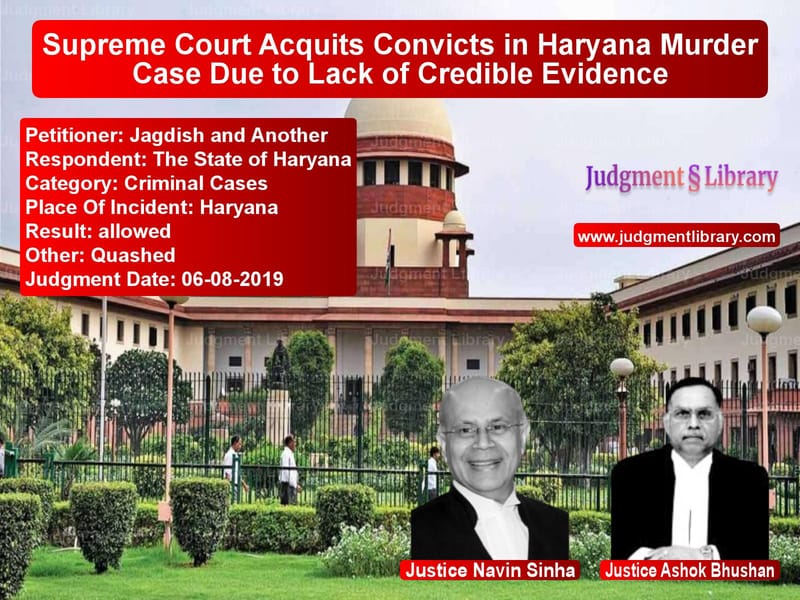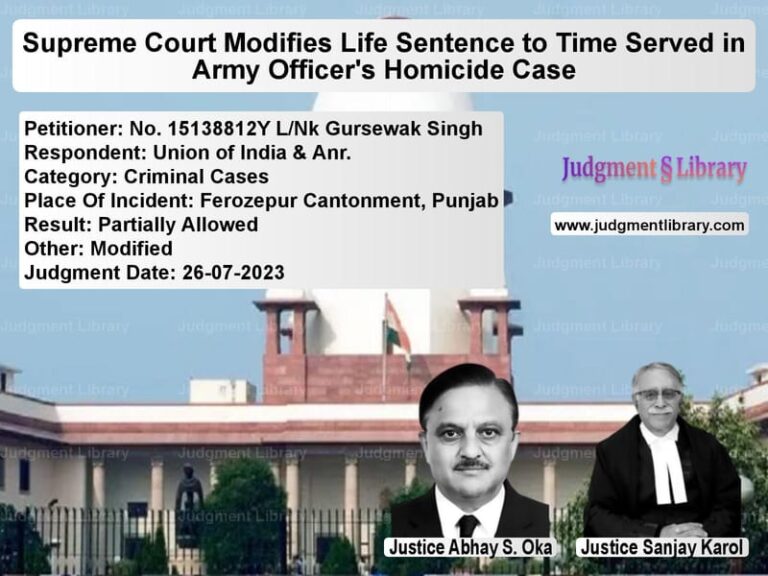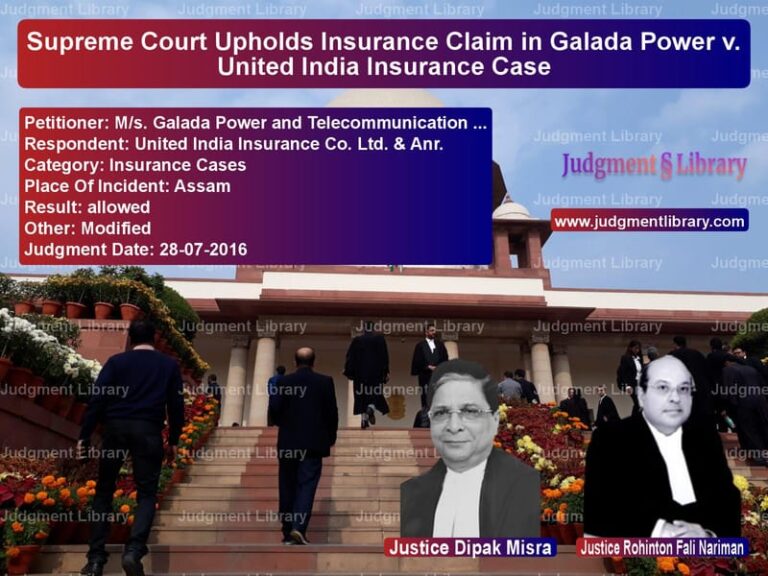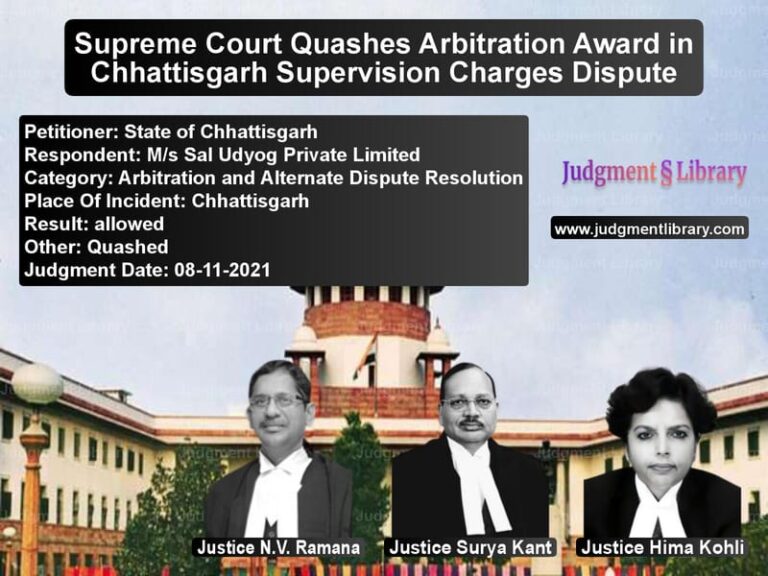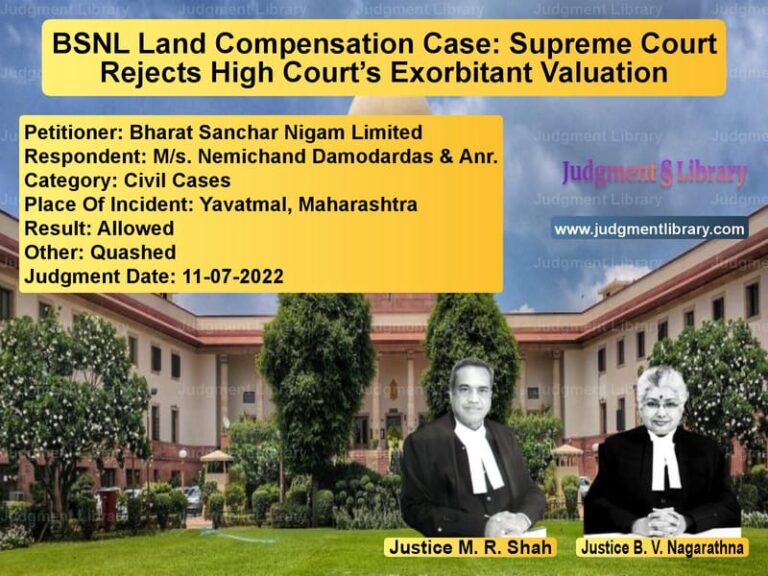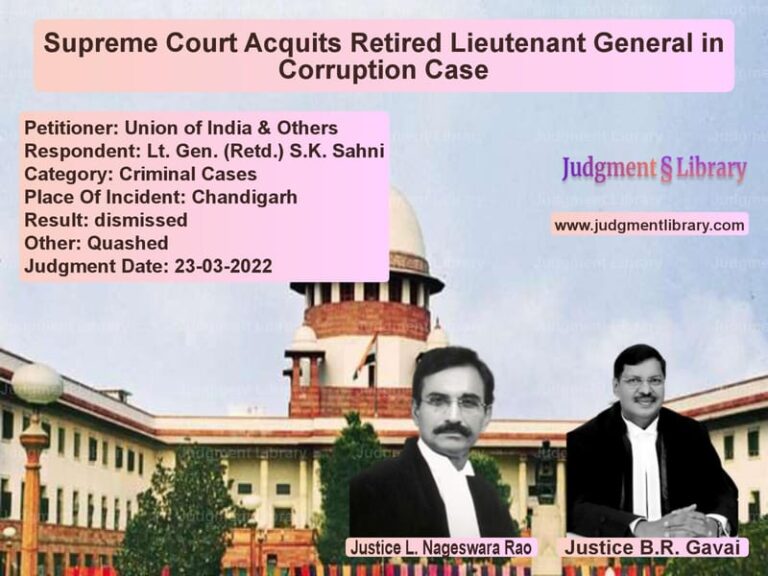Supreme Court Acquits Convicts in Haryana Murder Case Due to Lack of Credible Evidence
The case of Jagdish and Another v. The State of Haryana revolved around a murder trial where the appellants were convicted under Sections 302, 149, and 148 of the Indian Penal Code (IPC). The Supreme Court was tasked with determining whether the conviction was justified based on the available evidence, particularly when other accused in the case had been acquitted.
The case involved multiple accused persons, but only some were tried and convicted, leading to a question of whether the remaining two accused could be convicted under Section 149 IPC when others had been acquitted. The Supreme Court ultimately ruled in favor of the appellants, citing a lack of credible evidence and inconsistencies in witness testimonies.
Background of the Case
Initially, 13 accused were named in the case. Only six were charge-sheeted, with two of them being juveniles tried separately. The trial court convicted three persons, but one, Ishwar, was acquitted by the High Court. This left only two appellants, Jagdish and another accused, whose conviction was challenged in the Supreme Court.
The prosecution alleged that the appellants, along with other accused, had committed the murder due to pre-existing animosity between the parties. The prosecution relied on two eyewitnesses, PW-1 and PW-8, to establish their case.
Arguments by the Appellants
The appellants, represented by senior counsel S.R. Singh, contended that:
- The conviction under Section 149 IPC was unsustainable since most of the accused had been acquitted.
- The High Court erred in convicting them under Section 34 IPC without framing charges under that section.
- There was no evidence of common intention or pre-planned assault.
- The key prosecution witnesses, PW-1 and PW-8, were not credible and were not present at the scene during the assault.
- Even if the assault was proved, at best, it could amount to an offense under Section 304 Part II IPC.
Arguments by the Respondent (State of Haryana)
The State, opposing the appeal, argued that:
- PW-1 and PW-8 were credible witnesses who had directly seen the incident.
- The attack took place in a well-lit area, making it possible for witnesses to identify the assailants.
- The deceased suffered multiple injuries, proving that it was a deliberate and brutal attack.
Key Observations by the Supreme Court
After carefully considering the arguments and reviewing the case records, the Supreme Court made several important observations:
- There was prior animosity between the parties due to a dispute involving the son of one of the appellants.
- The attack allegedly took place at 9:00 PM when the deceased was returning from PW-1’s house.
- PW-1 and PW-8, who were presented as eyewitnesses, had inconsistencies in their statements.
- There was a significant delay in filing the FIR, which was registered at 3:00 AM, raising doubts about the authenticity of the allegations.
- The prosecution did not examine two key witnesses who were supposedly present at the scene.
Supreme Court’s Judgment
The Supreme Court found several inconsistencies in the prosecution’s case:
- PW-1 initially made general allegations against all 13 accused but later changed her statement, specifying individual roles in the attack.
- The medical report showed 11 injuries on the deceased, including incised wounds, but the appellants were only armed with lathis, which could not have caused such injuries.
- The eyewitness accounts did not match the physical evidence.
- The trial court itself noted that PW-1’s testimony “does not contain the entire truth.”
The Supreme Court ruled:
“We do not consider it safe and cannot rule out false implication to uphold the conviction of the appellants on the evidence of a doubtful solitary witness.”
The Court emphasized that a conviction based on a single eyewitness requires heightened scrutiny, particularly when that witness has credibility issues. The Supreme Court cited previous rulings reinforcing this principle:
- State of Rajasthan v. Bhola Singh (1994): A sole eyewitness’s testimony must be wholly reliable and free from major contradictions.
- Lallu Manjhi v. State of Jharkhand (2003): If multiple people attacked a victim, medical evidence should corroborate the number of assailants.
Since the evidence against the appellants was weak and circumstantial, the Supreme Court ruled that they could not be convicted based on the testimony of a single doubtful eyewitness.
Final Verdict
The Supreme Court allowed the appeal and acquitted the appellants, stating:
“The possibility of false implication cannot be ruled out completely in the facts of the case. The appeal is allowed, and the appellants are acquitted.”
The Court directed the immediate release of the appellants unless they were required in any other cases.
Implications of the Judgment
This ruling reinforces several key legal principles:
- Importance of credible eyewitness testimony: Convictions should not be based solely on uncorroborated testimony.
- Burden of proof: The prosecution must establish guilt beyond a reasonable doubt.
- Fair trial standards: Courts should carefully scrutinize evidence when pre-existing animosity exists between parties.
- Protection against false implications: When multiple accused are acquitted, the conviction of a few remaining accused should be reassessed.
Conclusion
The Supreme Court’s ruling in Jagdish and Another v. The State of Haryana highlights the significance of consistent and reliable evidence in criminal trials. The judgment serves as an important precedent in cases where convictions are based on weak or uncorroborated eyewitness testimonies. It underscores the fundamental legal principle that an accused must be convicted only if the prosecution’s case is free from reasonable doubt. The ruling also acts as a safeguard against wrongful convictions due to pre-existing enmity or motivated false accusations.
Petitioner Name: Jagdish and Another.Respondent Name: The State of Haryana.Judgment By: Justice Navin Sinha, Justice Ashok Bhushan.Place Of Incident: Haryana.Judgment Date: 06-08-2019.
Don’t miss out on the full details! Download the complete judgment in PDF format below and gain valuable insights instantly!
Download Judgment: Jagdish and Another vs The State of Haryana Supreme Court of India Judgment Dated 06-08-2019.pdf
Direct Downlaod Judgment: Direct downlaod this Judgment
See all petitions in Murder Cases
See all petitions in Bail and Anticipatory Bail
See all petitions in Custodial Deaths and Police Misconduct
See all petitions in Judgment by Navin Sinha
See all petitions in Judgment by Ashok Bhushan
See all petitions in allowed
See all petitions in Quashed
See all petitions in supreme court of India judgments August 2019
See all petitions in 2019 judgments
See all posts in Criminal Cases Category
See all allowed petitions in Criminal Cases Category
See all Dismissed petitions in Criminal Cases Category
See all partially allowed petitions in Criminal Cases Category

